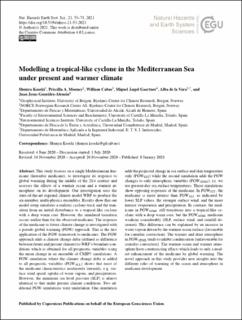| dc.contributor.author | Koseki, Shunya | |
| dc.contributor.author | Mooney, Priscilla A. | |
| dc.contributor.author | Cabos, William | |
| dc.contributor.author | Angel Gaertner, Miguel | |
| dc.contributor.author | de la Vara, Alba | |
| dc.contributor.author | Gonzalez-Aleman, Juan Jesus | |
| dc.date.accessioned | 2022-04-11T08:44:29Z | |
| dc.date.available | 2022-04-11T08:44:29Z | |
| dc.date.created | 2021-03-24T16:02:56Z | |
| dc.date.issued | 2021 | |
| dc.identifier.issn | 1561-8633 | |
| dc.identifier.uri | https://hdl.handle.net/11250/2990874 | |
| dc.description.abstract | This study focuses on a single Mediterranean hurricane (hereafter medicane), to investigate its response to global warming during the middle of the 21st century and assesses the effects of a warmer ocean and a warmer atmosphere on its development. Our investigation uses the state-of-the-art regional climate model WRF to produce the six-member, multi-physics ensembles. Results show that our model setup simulates a realistic cyclone track and the transition from an initial disturbance to a tropical-like cyclone with a deep warm core. However, the simulated transition occurs earlier than for the observed medicane. The response of the medicane to future climate change is investigated with a pseudo global warming (PGW) approach. This is the first application of the PGW framework to medicanes. The PGW approach adds a climate change delta (defined as difference between future and present climate) to WRF's boundary conditions which is obtained for all prognostic variables using the mean change in an ensemble of CMIP5 simulations. A PGW simulation where the climate change delta is added to all prognostic variables (PGWALL) shows that most of the medicane characteristics moderately intensify, e.g. surface wind speed, uptake of water vapour, and precipitation. However, the minimum sea level pressure (SLP) is almost identical to that under present climate conditions. Two additional PGW simulations were undertaken; One simulation adds the projected change in sea surface and skin temperature only (PGWSST) while the second simulation adds the PGW changes to only atmospheric variables (PGWATMS); i.e. we use present-day sea surface temperatures. These simulations show opposing responses of the medicane. In PGWSST, the medicane is more intense than PGWALL as indicated by lower SLP values, the stronger surface wind, and the more intense evaporation and precipitation. In contrast, the medicane in PGWATMS still transitions into a tropical-like cyclone with a deep warm core, but the PGWATMS medicane weakens considerably (SLP, surface wind, and rainfall decrease). This difference can be explained by an increase in water vapour driven by the warmer ocean surface (favourable for cumulus convection). The warmer and drier atmosphere in PGWATMS tends to inhibit condensation (unfavourable for cumulus convection). The warmer ocean and warmer atmosphere have counteracting effects which leads to only a modest enhancement of the medicane by global warming. The novel approach in this study provides new insights into the different roles of warming of the ocean and atmosphere in medicane development. | en_US |
| dc.language.iso | eng | en_US |
| dc.publisher | Copernicus Publications | en_US |
| dc.rights | Navngivelse 4.0 Internasjonal | * |
| dc.rights.uri | http://creativecommons.org/licenses/by/4.0/deed.no | * |
| dc.title | Modelling a tropical-like cyclone in the Mediterranean Sea under present and warmer climate | en_US |
| dc.type | Journal article | en_US |
| dc.type | Peer reviewed | en_US |
| dc.description.version | publishedVersion | en_US |
| dc.rights.holder | Copyright 2021 The Author(s) | en_US |
| cristin.ispublished | true | |
| cristin.fulltext | original | |
| cristin.qualitycode | 1 | |
| dc.identifier.doi | 10.5194/nhess-21-53-2021 | |
| dc.identifier.cristin | 1900763 | |
| dc.source.journal | Natural hazards and earth system sciences | en_US |
| dc.source.pagenumber | 53-71 | en_US |
| dc.relation.project | European Regional Development Fund: CGL2017-89583-R | en_US |
| dc.relation.project | Notur/NorStore: NS9039K | en_US |
| dc.identifier.citation | Natural hazards and earth system sciences. 2021, 21, 53-71. | en_US |
| dc.source.volume | 21 | en_US |

